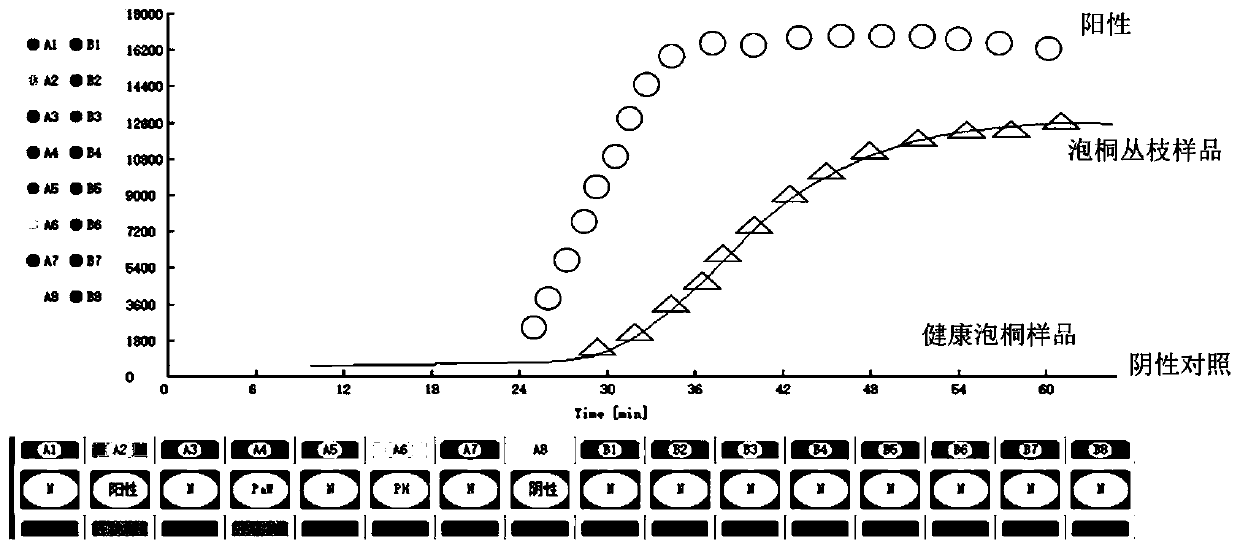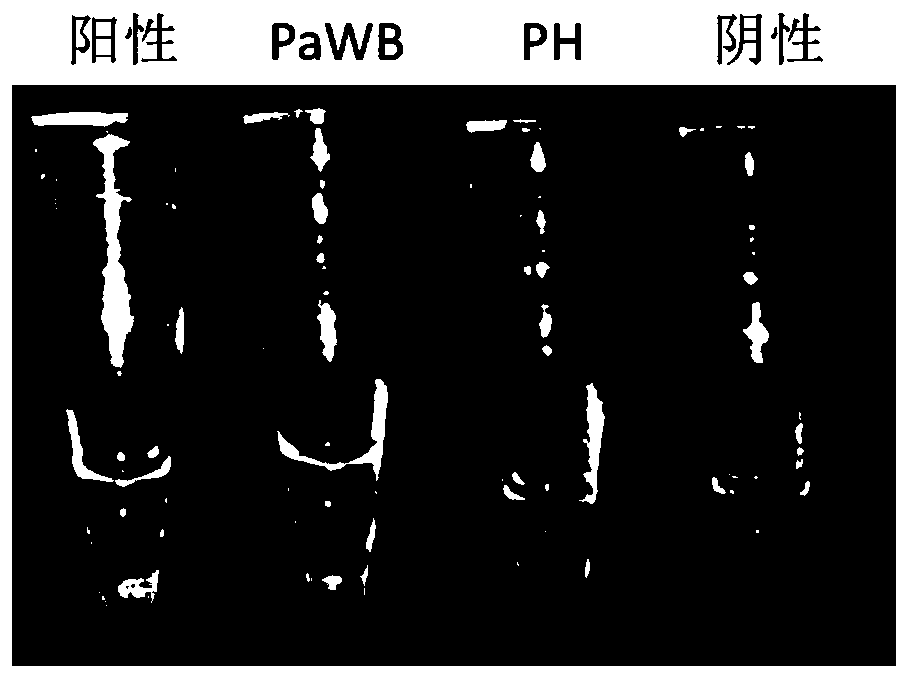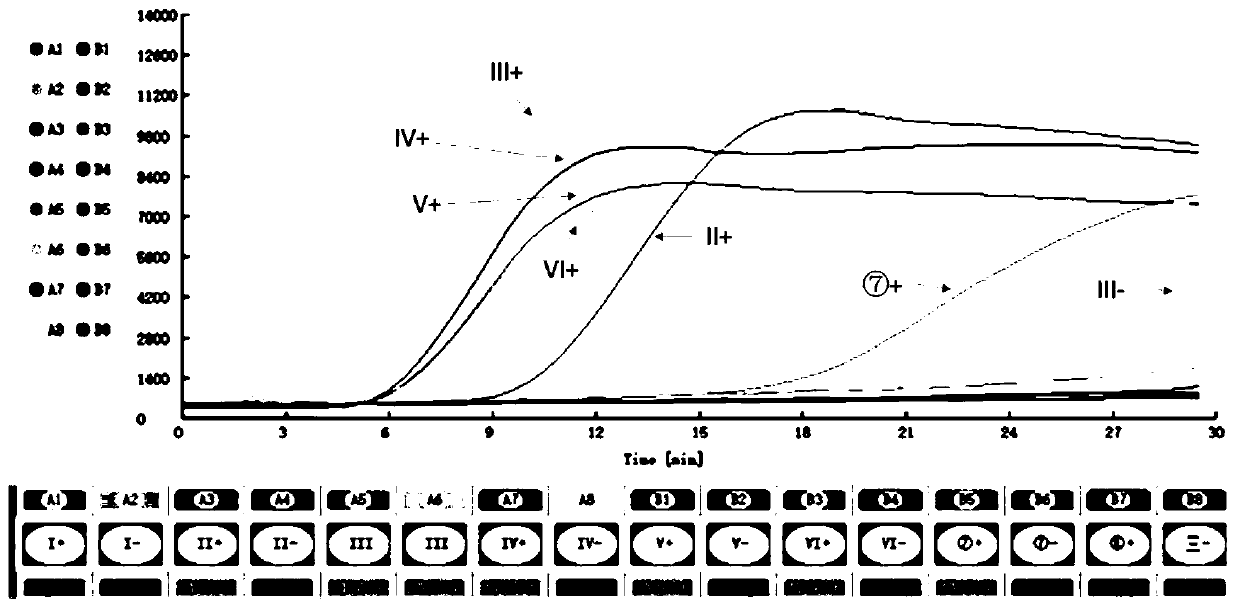Lamp primer set for detecting phytoplasma and its kit and application
A phytoplasma and primer set technology, applied in biochemical equipment and methods, recombinant DNA technology, microbial measurement/inspection, etc., can solve the problem of limiting the use and promotion of diagnostic methods, high technical requirements for testing personnel, complex operating procedures, etc. problems, to achieve the effect of eliminating instrument investment, improving detection sensitivity, and high sensitivity
- Summary
- Abstract
- Description
- Claims
- Application Information
AI Technical Summary
Problems solved by technology
Method used
Image
Examples
Embodiment 1
[0059] Example 1 Establishment of a Rapid Detection Method for Paulownia Arbuscular Disease Phytoplasma Ring-Mediated Isothermal Amplification
[0060] 1. Extraction of total plant DNA
[0061] The plant genome extraction kit (Plant Genomic DNA Kit, Adelaide Biotechnology Co., Ltd.) was used to extract the total DNA of the plants to be tested, and stored in a -20°C refrigerator for later use.
[0062] 2. LAMP amplification
[0063] Reaction system: total volume 45 μL, containing: 10 μM PaWB3-F3 0.5 μL, 10 μM PaWB3-B3 0.5 μL, 40 μM PaWB3-FIP 1 μL, 40 μM PaWB3-BIP 1 μL, LAMP reaction solution RM (2×) 12.5 μL, 8 U / μL Bst 1 μL of DNA polymerase, 0.5 μL of fluorescent dye 10×SYBR Green Ⅰ, 0.5 μL of sample DNA to be tested, made up to 25 μL with ultrapure water, and added 20 μL of sealing solution at the same time.
[0064] Reaction conditions: Mix the configured reaction tubes and centrifuge, place at 63°C for 60 minutes, and inactivate at 80°C for 5 minutes.
[0065] 3. Judgmen...
experiment example 2
[0068] Preparation and preliminary screening of experimental example 2 primers
[0069] 1. Experimental method
[0070] 1.1 Primer design and synthesis
[0071] The nucleic acid sequences of different groups of phytoplasma 16S genes and tuf genes were collected in GeneBank, and DNAMAN software was used to compare and compare the above sequences to find out Paulownia arbuscules, Neem arbuscules, mulberry atrophy, lettuce yellowing and periwinkle The genetic difference sites and highly conserved regions between the green-shifting (16Sr I group) phytoplasma and other groups of phytoplasma, using the LAMP primer online design software Primer Explorer V4 to design 6 regions of the 16S gene and tuf gene conserved sequences of the 16SrI group phytoplasma specific primers. Among them, 6 sets of primer sets (I-VI) were designed for the phytoplasma 16S gene, and two sets of primer sets (⑦ and ⑧) were designed for the tuf gene. The results are shown in Table 1. level synthesis.
[00...
Embodiment 3
[0084] Example 3 specificity test
[0085] 1. Test method
[0086] According to the loop-mediated isothermal amplification reaction system established in the above-mentioned Example 1, the pathogenic and healthy tissue samples of Paulownia arbuscules, neem arbuscules, mulberry wilt, periwinkle greening and lettuce yellowing in the 16SI group were simultaneously tested; 16SII The diseased and healthy tissue samples of peanut arbuscules, sweet potato arbuscules and stinky cabbage arbuscules in group 16SⅤ; the diseased and healthy tissue samples of jujube madness, pagoda tree arbuscules, cherry lethal yellowing and Chongyang wood arbuscules in group 16SⅤ; 16SXIV The incidence of chestnut yellowing and healthy tissue samples; and to sterilize ddH 2 O As a negative control, the specificity test of Paulownia arbuscular, Neem arbuscular, Mulberry wilting disease, periwinkle greening and lettuce yellowing phytoplasma ring-mediated amplification was performed.
[0087] The pathogenic...
PUM
 Login to View More
Login to View More Abstract
Description
Claims
Application Information
 Login to View More
Login to View More - R&D
- Intellectual Property
- Life Sciences
- Materials
- Tech Scout
- Unparalleled Data Quality
- Higher Quality Content
- 60% Fewer Hallucinations
Browse by: Latest US Patents, China's latest patents, Technical Efficacy Thesaurus, Application Domain, Technology Topic, Popular Technical Reports.
© 2025 PatSnap. All rights reserved.Legal|Privacy policy|Modern Slavery Act Transparency Statement|Sitemap|About US| Contact US: help@patsnap.com



